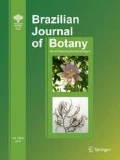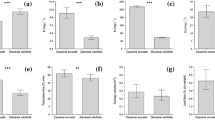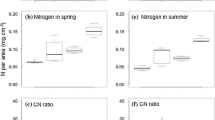Abstract
We tested the hypothesis that tree species adapted to ecotones between forest-swamps have leaf structures varying in response to land water saturation (drained and wetland), which could further influence their resistance against insect herbivory. The hypothesis was tested at the crown and leaf scale. We assessed differences in the plant architecture (height, circumference at breast height, trunk height, and crown) and leaf traits (sclerophylly and anatomy) of tree species inhabiting wetland and drained soils and investigated which variables explained variance in leaf herbivory rates. The study was conducted in Montane and wetland Forests in the Itacolomi State Park, in Southern Brazil, focusing on the Clethra scabra Pers., which inhabits both habitats, and also Myrcia amazonica DC. and Myrcia laruotteana Cambess (congeneric) which inhabit Montane forest and wetland forest, respectively. It was found that C. scabra individuals in wetland areas had simpler crown structure and higher leaf sclerophylly rates than those individuals of this species in the drained habitat. However, the two C. scabra populations did not differ regarding overall foliage thickness and damage by herbivory between drained and wetland habitats. Variables that were related to herbivory in this species were adaxial epidermis thickness and circumference at breast height. Myrcia individuals from wetland areas had less damaged leaves but thinner epidermis than in drained soils, but no variable correlated to herbivory at the leaf scale. Our hypothesis was partially corroborated and suggests that C. scabra is more influenced by soil saturation than Myrcia, and its herbivory is related with structural and anatomic parameters.






Similar content being viewed by others
References
Agrawal AA (2001) Phenotypic plasticity in the interactions and evolution of species. Science 294:321–326. doi:10.1126/science.1060701
Bradshaw AD (1965) Evolution significance of phenotypic plasticity in plants. In: Caspari EW, Thoday JM (eds) Advances in genetics, vol 13. Academic Press, New York, pp 115–154
Coley PD, Barone JA (1996) Herbivory and plant defenses in tropical forests. Annu Rev Ecol Syst 27:305–335
Coley PD, Bryant JP, Chapin FS (1985) Resource availability and plant antiherbivore defense. Science 230:890–899
Crawford RMM, Braendle R (1996) Oxygen deprivation stress in a changing environment. J Exp Bot 295:145–159
Davanso-Fabro VM, Medri ME, Bianchini E, Pimenta JA (1998) Tolerância à inundação: aspectos da anatomia ecológica e do desenvolvimento de Sesbania virgata (Cav.) Pers. (Fabaceae). Braz Arch Biol Technol 41:475–482
Dirzo R, Domínguez CA (1995) Plant-herbivore interactions. In: Bullock SH, Mooney A, Medina E (eds) Seasonally dry tropical forest. Cambridge University Press, Cambridge, pp 305–332
Espírito-Santo NB, Ribeiro SP, Lopes JFS (2012) Evidence of competition between two canopy ant species: is aggressive behavior innate or shaped by a competitive environment? Psyche. doi:10.1155/2012/609106
Feeny P (1976) Plant appearance and chemical defense. In: Wallace JW, Mansell RL (eds) Biochemical interaction between plants and insects. Springer, New York, pp 1–40
Fleck T, Fonseca CR (2007) Hipóteses sobre a riqueza de insetos galhadores: uma revisão considerando os níveis intraespecífico, interespecífico e de comunidade. Neotrop Biol Conserv 2:36–45
Fujaco MAG, Leite MGP, Messias MCTB (2010) Análise multidimensional das mudanças no uso e ocupação do Parque Estadual do Itacolomi (MG) através de técnicas de geoprocessamento, vol 63. Rev Escola de Minas, Ouro Preto, pp 695–701
Gershenzon J (1984) Changes in the levels of plant secondary metabolites under water and nutrient stress. In: Timmerman BN (ed) Phytochemical adaptations to stress. Plenum Press, New York
Herms DA, Mattson WJ (1992) The dilemma of plants: to grow or defend. Q Rev Biol 67:283–335. doi:10.1086/417659
Hurt GW (2005) Hydric soils. Encycl Soil Environ 1:212–217. doi:10.1016/B0-12-348530-4/00030-8
Johansen DA (1940) Plant micro technique. McGraw-Hill Book, New York
Jordan GJ, Dillon RA, Weston PH (2005) Solar radiation as a factor in the evolution of scleromorphic leaf anatomy in Proteaceae. Am J Bot 92:789–796
Kazemi-Dinan A, Thomaschky S, Stein RJ, Krämer U, Müller C (2014) Zinc and cadmium hyperaccumulation act as deterrents towards specialist herbivores and impede the performance of a generalist herbivore. New Phytol 202:628–639
Kraus JE, Arduin M (1997) Manual básico de métodos em morfologia vegetal. EDUR, Seropédica
Larcher W (2000) Ecofisiologia vegetal. Rima Artes e Texto, São Carlos
Lawton JH (1983) Plant architecture and the diversity of phytophagous insects. Annu Rev Entomol 28:23–29
Lorenzi H (1998) Árvores brasileiras: manual de identificação e cultivo de plantas arbóreas nativas do Brasil. Editora Plantarum, Nova Odessa
Lourenço GM, Campos RBF, Ribeiro SP (2015) Spatial distribution of insect guilds in a tropical montane rainforest: effects of canopy structure and numerically dominant ants. Arthropod Plant Interact 9:163–174
Loveless AR (1961) A nutritional interpretation of sclerophylly based on differences in the chemical composition of sclerophyllous and mesophytic leaves. Ann Bot 25:168–184
MacArthur R (1967) Limiting similarity, convergence and divergence of coexisting species. Am Nat 101:377–385
Marquis RJ, Morais HC, Diniz IR (2002) Interactions among cerrado plants and their herbivores: unique or typical? In: Oliveira OS, Marquis RJ (eds) The cerrados of Brazil. Columbia University, New York
Medri ME, Bianchini E, Pimenta JA, Colli S, Muller C (2002) Estudos sobre a tolerância ao alagamento em espécies arbóreas nativas da bacia do rio Tibagi. In: Medri ME, Bianchini E, Shibatta OA, Pimenta JA (eds) A bacia do rio Tibagi. Edição dos editores, Londrina, pp 133–172
Metcalfe DB, Asner GP, Martin RE, Espejo JES et al (2014) Herbivory makes major contributions to ecosystem carbon and nutrient cycling in tropical forests. Ecol Lett 17:324–332. doi:10.1111/ele.12233
Molina-Montenegro MA, Ávila P, Hurtado R, Valdivia AI, Gianoli E (2006) Leaf trichrome density may explain herbivory patterns of Actinote sp. (Lepidoptera: Acraeidae) on Liabum mandonii (Asteraceae) in a montane humid forest (Nor Yungas, Bolivia). Acta Oecol 30:147–150. doi:10.1016/j.actao.2006.02.008
Myers N, Mittermeier RA, Mittermeier CG, Fonseca GAB, Kent J (2000) Biodiversity hotspots for conservation priorities. Nat 403:853–858
Neves FS, Sperber CF, Ricardo I, Soares CJP, Ribeiro SP (2013) Contrasting effects of sampling scale on insect herbivores distribution in response to canopy structure. Rev Biol Trop 61:125–137
Pedreira G, Sousa HC (2011) Comunidade arbórea de uma mancha florestal permanentemente alagada e de sua vegetação adjacente em Ouro Preto-MG, Brasil. Ciênc Florest 21:663–675
Pereira JA (2015) Herbivoria foliar em populações e espécies arbóreas cogenéricas entre florestas paludosas e de encosta. Dissertation, Federal University of Ouro Preto, Ouro Preto
Plaza S, Weber J, Pajonk S, Thomas J, Talke IN, Schellenberg M, Pradervand S, Burla B, Geisler M, Martinoia E, Krämer U (2015) Wounding of Arabidopsis halleri leaves enhances cadmium accumulation that acts as a defense against herbivory. Biometals 3:521–528
R Core Team (2015) R: A language and environment for statistical computing. R Foundation for Statistical Computing, Vienna. http://www.r-project.org/
Ribeiro SP (2003) Insect herbivores in the canopies of savannas and rainforests. In: Basset Y, Novotny V, Miller S, Kitching R (eds) Arthropods of tropical forests: spatial-temporal dynamics and resource use in the canopy. Cambridge Press, New York, pp 348–359
Ribeiro SP, Basset Y (2007) Gall-forming and free-feeding herbivory along vertical gradients in a lowland rainforest: the importance of leaf sclerophylly. Ecography 30:663–672
Ribeiro SP, Brown VK (1999) Insect herbivory in tree crowns of Tabebuia aurea and T. ochracea (Bignoniaceae): contrasting the Brazilian cerrado with the wetland Pantanal Matogrossense. Selbyana 20:159–170
Ribeiro SP, Pimenta HR, Fernandes GW (1994) Herbivory by chewing and sucking insects on Tabebuia ochracea. Biotropica 26:302–307
Ribeiro SP, Borges PP, Gaspar C, Melo C, Serrano ARM et al (2005) Canopy insect herbivores in the Azorean laurisilva forests: key host plant species in a highly generalist insect community. Ecography 28:315–330
Ribeiro SP, Londe V, Bueno A, Barbosa JS, Corrêa TL, Soeltl T et al (2016) Plant defense against leaf herbivory based on metal accumulation: examples from a tropical high altitude ecosystem. Plant Species Biol. http://onlinelibrary.wiley.com/doi/10.1111/1442-1984.12136/abstract
Ribiero SP, Basset Y (2016) Effects of sclerophylly and host choice on gall densities and herbivory distribution in an Australian subtropical forest. Austral Ecol 41:219–226
Schlichting CD (1986) The evolution of phenotypic plasticity in plants. Annu Rev Ecol Syst 17:667–693. doi:10.1146/annurev.es.17.110186.003315
Semad—Secretaria de Estado de Meio Ambiente e Desenvolvimento (2007) Plano de Manejo do Parque Estadual do Itacolomi. Instituto Estadual de Florestas de Minas Gerais, Belo Horizonte
Sobral M (2007) A evolução do conhecimento taxonômico no Brasil (1990–2006) e um estudo de caso: a família Myrtaceae no município de Santa Teresa, ES. Thesis, Federal University of Minas Gerais, Belo Horizonte
Sobral M, Jarenkow JA, Brack P, Irgang B, Larocca J, Rodrigues RS (2013) Flora arbórea e arborescente do Rio Grande do Sul. RiMa, São Carlos
Souza VC, Lorenzi H (2005) Botânica sistemática: guia ilustrado para identificação das famílias de Angiospermas da flora brasileira, baseado em APG II. Editora Plantarum, Nova Odessa
Strong DR, Lawton JH, Southwood R (1984) Insects on plants: community patterns and mechanisms. Blackwell Scientific, Oxford
Sultan SE (2000) Phenotypic plasticity for plant development, function and life history. Trends Plant Sci 5:537–542. doi:10.1016/S1360-1385(00)01797-0
Sultan SE, Wilczek AM, Hann SD, Brosi BJ (1998) Contrasting ecological breadth of co-occurring annual Polygonum species. J Ecol 86:363–383. doi:10.1046/j.1365-2745.1998.00265.x
Turner IM (1994) A quantitative analysis of leaf form in woody plants from the world’s major broadleaved forest types. J Biogeogr 21:413–419
Valverde PL, Fornoni J, Núñez-Farfán J (2001) Defensive role of leaf trichrome in resistance to herbivorous insects in Datura stramonium. J Evol Biol 14:424–432. doi:10.1046/j.1420-9101.2001.00295.x
Zuur A, Ieno EM, Smith GM (2007) Analyzing ecological data. Statistic for biology and health series. Springer, New York
Acknowledgements
The authors thank the Federal University of Ouro Preto (UFOP) for the master’s scholarship to the first author, the Department of Transport (UFOP) for logistical support in field, the students of scientific initiation Paula T. Gomes and Dhiordan Deon for their assistance in field and laboratory, and the Forest State Institute of Minas Gerais (IEF) for allowing this study at the PEIT.
Author information
Authors and Affiliations
Corresponding author
Rights and permissions
About this article
Cite this article
Pereira, J.A., Londe, V., Ribeiro, S.P. et al. Crown architecture and leaf anatomic traits influencing herbivory on Clethra scabra Pers.: comparing adaptation to wetlands and drained habitats. Braz. J. Bot 40, 481–490 (2017). https://doi.org/10.1007/s40415-016-0343-2
Received:
Accepted:
Published:
Issue Date:
DOI: https://doi.org/10.1007/s40415-016-0343-2




